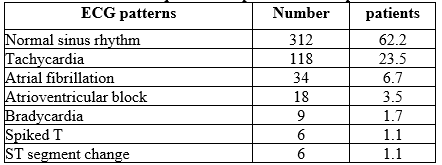General characteristics and laboratory findings of patients admitted to medicine department of a tertiary care hospital with electrolyte imbalance
Abstract
Introduction: Electrolyte imbalance (EI) is an independent predictor of mortality and has of great clinical importance because these disorders have been associated with an increased risk of morbidity and mortality. Thus, prompt diagnosis and treatment are crucial in the management of patients admitted to the medicine department.
Objective: To assess the general characteristics and laboratory findings of patients admitted to the medicine department of a tertiary care hospital with electrolyte imbalance.
Materials and Methods: This retrospective study was conducted on patients attending the medicine department of Enam Medical College Hospital, Savar, Bangladesh over a period of six months from January to June 2022. A total of 501 patients over 18 years of age who presented in the medicine department with different electrolyte disturbance was included in this study. After admission and clinical examinations, data were collected from the patients after having a written informed consent from them.
Results: Among, 501 patients with electrolyte imbalance, 55% (n=275) were male and 45% (n=226) female. The mean age of patients was 59.28 ±16.79 years. The most common symptoms of the patients were dyspnoea (14.9%, n=75), fever (13.9%, n=70), and systemic deterioration (12.1%, n=61). Most and least frequent electrolyte imbalances were hyponatremia and hypermagnesemia, respectively. Confusion (14.1%), oedema (10.0%) and rales (9.0%) were most frequently seen in physical examination. ECG examinations revealed normal sinus rhythm in 62.2% of the patients, and most frequent pathological findings were tachycardia (23.5%) and atrial fibrillation (6.7%). Most frequent oncological diagnoses in these patients were lung and haematological malignancies. By physical, clinical, and laboratory examinations, sepsis was frequently diagnosed in 10.5% of the patients, pneumonia in 8.7%, and acute renal failure in 7.1%. All patients had at least one comorbid condition.
Conclusion: Patients admitted to the medicine department with electrolyte imbalance require close evaluation and frequent laboratory draws depending on the duration and severity of underlying disease states. In our study, our patients were diagnosed with various oncological diseases (39.5%). These malignancies expose a major risk for electrolyte imbalances. Most patients undergoing therapy for the electrolyte abnormalities require longer hospital stays depending upon the severity and acuity of different electrolytes.
Downloads
References
Arampatzis S, Funk GC, Leichtle AB, Fiedler GM, Schwarz C, Zimmermann H, et al. Impact of diuretic therapy-associated electrolyte disorders present on admission to the emergency department: a cross-sectional analysis. BMC Med 2013; 11:83–9.
Funk GC, Lindner G, Druml W, Metnitz B, Schwarz C, Bauer P, et al. Incidence and prognosis of dysnatremias present on ICU admission. Intensive Care Med 2010; 36(2):304–11.
Balci AK, Koksal O, Kose A, Armagan E, Ozdemir F, Inal T, et al. General characteristics of patients with electrolyte imbalance admitted to emergency department. World J Emerg Med 2013;4(2):113–6.
Lindner G, Pfortmüller CA, Leichtle AB, Fiedler GM, Exadaktylos AK. Age-related variety in electrolyte levels and prevalence of dysnatremias and dyskalemias in patients presenting to the emergency department. Gerontology 2014;60(5):420–3 [Epub 2014 May 20].
Marti G, Schwarz C, Leichtle AB, Fiedler GM, Arampatzis S, Exadaktylos AK, et al. Etiology and symptoms of severe hypokalemia in emergency department patients. Eur J Emerg Med 2014;21(1):46–51.
Najeeb Q, Ruqaya A, Sajad H, Sabiya M, Ruhi A. Electrolyte abnormalities in patients admitted in emergency department of tertiary care institute: a cross sectional study. Int J Med Sci Public Health 2014;3(11):1368–71.
Bockenkamp B, Vyas H. Understanding and managing acute fluid and electrolyte disturbances. Current Paediatrics. 2003; 13:520–528. [Google Scholar]
Ito H, Fujimaki H, Inoue J, Shiraki M. Disorders of fluid and electrolyte metabolism in elderly diabetics. Nihon Ronen Igakkai Zasshi. 1989; 26:233–239. [PubMed] [Google Scholar]
Goldberg A, Hammerman H, Petcherski S, Zdorovyak A, Yalonetsky S, Kapeliovich M, et al. Prognostic importance of hyponatremia in acute ST-elevation myocardial infarction. Am J Med. 2004; 117:242–248
Singal BM, Hedges JR, Succop PA. Efficacy of the stat serum electrolyte panel in the management of older emergency patients. Med Decis Making. 1992; 12:52–59.
Mahowald JM, Himmelstein DU. Hypernatremia in the elderly: relation to infection and mortality. J Am Geriatr Soc. 1981; 29:177–180. [PubMed] [Google Scholar]
Sonnenblick M, Algur N. Hypernatremia in the acutely ill elderly patients: role of impaired arginine-vasopressin secretion. Miner Electrolyte Metab. 1993; 19:32–35. [PubMed] [Google Scholar]
Solini A, Zamboni P, Passaro A, Fellin R, Ferrannini E. Acute vascular events and electrolytes variations in elderly patients. Horm Metab Res. 2006; 38:197–202. [PubMed] [Google Scholar]
Clark BA, Shannon RP, Rosa RM, Epstein FH. Increased susceptibility to thiazide-induced hyponatremia in the elderly. J Am Soc Nephrol. 1994; 5:1106–1111. [PubMed] [Google Scholar]
Miller PD, Krebs RA, Neal BJ, McIntyre DO. Hypodipsia in geriatric patients. Am J Med. 1982; 73:354–356. [PubMed] [Google Scholar]
Bilezikian JP. Etiologies and therapy of hypercalcemia. Endocrinol Metab Clin North Am 1989; 18: 389–414.
Williams ME, Rosa RM, Epstein FH. Hyperkalemia. Adv Intern Med 1986; 31: 265–291.
Whang R, Hampton EM, Whang DD. Magnesium homeostasis and clinical disorders of magnesium deficiency. Ann Pharmacother 1994; 28: 220–226.
Harring, TR., Deal, NS. and Kuo, DC. 2014. Disorders of sodium and water balance. Emerg Med Clin North Am., 32:379-401
Olsson, K., Ohlin, B. and Melander, O. 2013. Epidemiology and characteristics of hyponatremia in the emergency department. Eur J Intern Med., 24:110-116.



























